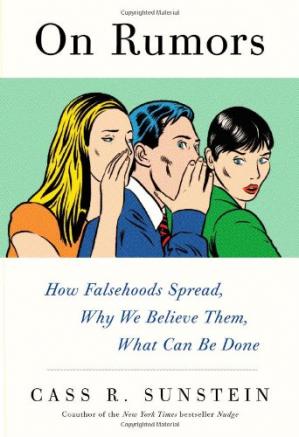On rumorshow falsehoods spread, why we believe them, what can be done
|

|
 Diese Seite wurde seit 4 Jahren inhaltlich nicht mehr aktualisiert.
Unter Umständen ist sie nicht mehr aktuell.
Diese Seite wurde seit 4 Jahren inhaltlich nicht mehr aktualisiert.
Unter Umständen ist sie nicht mehr aktuell.
 Zusammenfassungen
Zusammenfassungen
 Many of us are being misled. Claiming to know the “pals” of presidential aspirants, dark secrets about public officials, and hidden causes of the current economic crisis, those who spread rumors know precisely what they are doing. They are sometimes able to derail political candidates, injure companies and reputations, even damage democratic governance. And in the era of the Internet, they know more about manipulating the mechanics of false rumors—social cascades, group polarization, and biased assimilation—than you do. They also know that the presumed correctives—publishing balanced information, issuing corrections, and trusting to the marketplace of ideas—do not always work. A pioneer in the effort “to design regulation around the ways people behave” (The Wall Street Journal), Cass R. Sunstein uses examples from the real world and from behavioral studies to explain why certain rumors spread like wildfire and what we can do to avoid being misled.
Many of us are being misled. Claiming to know the “pals” of presidential aspirants, dark secrets about public officials, and hidden causes of the current economic crisis, those who spread rumors know precisely what they are doing. They are sometimes able to derail political candidates, injure companies and reputations, even damage democratic governance. And in the era of the Internet, they know more about manipulating the mechanics of false rumors—social cascades, group polarization, and biased assimilation—than you do. They also know that the presumed correctives—publishing balanced information, issuing corrections, and trusting to the marketplace of ideas—do not always work. A pioneer in the effort “to design regulation around the ways people behave” (The Wall Street Journal), Cass R. Sunstein uses examples from the real world and from behavioral studies to explain why certain rumors spread like wildfire and what we can do to avoid being misled. Dieses Buch erwähnt ...
Dieses Buch erwähnt ...
 Begriffe KB IB clear | chilling effect
, Gruppenpolarisation
, Informationinformation
,  Internet Internet internet
, internet
,  Reputation Reputation reputation
, reputation
,  Vertrauen Vertrauen trust trust
|
 Volltext dieses Dokuments
Volltext dieses Dokuments
 Bibliographisches
Bibliographisches 
 Beat und dieses Buch
Beat und dieses Buch
Beat hat dieses Buch während seiner Zeit am Institut für Medien und Schule (IMS) ins Biblionetz aufgenommen. Beat besitzt kein physisches, aber ein digitales Exemplar. (das er aber aus Urheberrechtsgründen nicht einfach weitergeben darf). Aufgrund der wenigen Einträge im Biblionetz scheint er es nicht wirklich gelesen zu haben. Es gibt bisher auch nur wenige Objekte im Biblionetz, die dieses Werk zitieren.















 Biblionetz-History
Biblionetz-History